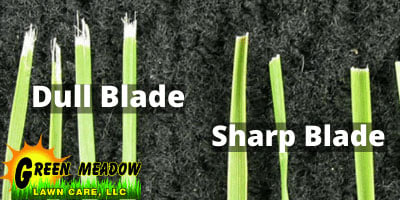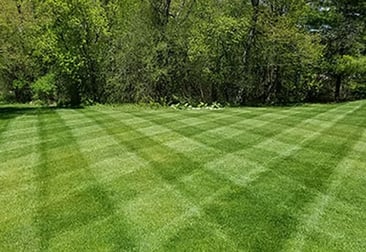Improve Your Mowing Practices with These Easy Tips
For homeowners, we recommend sharpening your lawn mower blades every 1-2 months. Keeping your mower blades sharp will result in nice clean cuts that can heal quickly. Dull lawn mower blades can lead to disease and bent blades can lead to lawn scalping. A sharpened mower blade is essential to your turf's health.

-
Dull Lawn Mower Blades
- Will tear grass.
- Make grass more prone to disease - fungi will take advantage of those jagged edges, especially in damp conditions.
-
Bent Lawn Mower Blades
- Can lead to uneven mowing or scalping when mower deck comes close to or hits ground.
- Can be the result of hitting obstacles in your yard such as tree stumps, rocks or drop-offs.
-
RPM
- Run your ride-on mower at full throttle. Mower blades will spin at a higher velocity leading to a cleaner grass blade cut.
How short should I cut my grass?
- Never cut more than 1/3 of the existing grass blade. This can stress the grass blade and lead to burns and brown spots.

- Summer: When temperatures rise set your mower deck to 3-3.5 inches. Long grass blades keep the roots shaded from the sun to retain moisture and avoid drought stress.
What time of day should I mow my lawn?
- Mow when dry: Avoid mowing in the early morning when grass is still wet from morning dew. Wet grass that is mowed will clump and result in dead spots in lawn if left behind.
- Speed: Don’t speed when mowing your lawn. Drive at a speed where the blades can keep up with how much grass they must cut. This will result in a much fresher slice of the grass blade and less clumps.
Should I leave my lawn clippings when I mow?
Yes! In most cases you want to leave your freshly mowed lawn clippings on your yard. Grass clippings are especially rich in Nitrogen and over the course of the year can be equivalent to an entire extra round of fertilizer being applied.
There can, however, be a few exceptions to this. You don't want to leave lawn clippings in your lawn if they
- Returns moisture to lawn.
- Returns nutrients to lawn.
- Acts as a natural fertilizer for soil.

Pro tip: If mower leaves unwanted clumps, raise blades 1/2 inch and mow your lawn a second time but in a different direction. This will break up clumps that would otherwise kill grass grass.
Should I alternate directions when I mow?
- Each time you mow, mow in a different direction to promote upright growth. Grass tends to lean towards the direction you mow over time.
- Mowing in the same pattern time and time again can also cause soil compaction and rutting in your soil.

Equipment:
- Ensure mower is not leaking oil or gas - this is toxic to your lawn.
- Always fill mower with fuel over a driveway/road or any area where a spill won’t damage your lawn.
- Clean mower deck frequently to avoid buildup of clippings
You're not as far away from a healthy lawn as you might think! If you change a few bad habits, your lawn will change drastically. By taking care of your grass, your yard will start to look like those neighbors that always seem to have the best lawns on the block. You can make the grass greener on your side by using these professional mowing techniques.
If this article was useful to you, read some others similar to it:
- Which Type of Grass is Best for my Lawn? Blue vs Rye vs Fescues?
- Cost of Lawn Care in Northern CT - Explained.
- 5 Best Ways to Seed Thin and Bare Lawns
- Best Ways to Prepare My Lawn for Spring
Since 2007, Green Meadow Lawn Care has provided homeowners throughout the greater Tolland, Connecticut area with premium fertilization programs, tick control, mosquito management, seeding & aeration and tree & shrub care.
Visit our Learning Center to find out more about how our services can help you or visit our Youtube Channel to view more in our Learning Center Series.
To speak to our Customer Service Manager, please call Dave (view Dave's video bio here) with any questions. Dave has been in the industry for 30 years and is always happy to help with his expert advice.
860-870-5700



